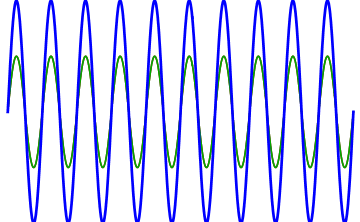I recently taught a class titled “The Physics of Music” and thought it would be fun to write a quick blog post explaining some of the basics terms of music and sound.
Sound: At the most basic level, sound is vibration that can be detected by our ears. Sound requires a source (something that is doing the vibrating) and a medium (something to carry the vibrations to our ears, usually air).
Frequency, or Hertz: Sound vibrations are measured in Hertz, or oscillations per second. For example, a tuning fork vibrating at 440 times per second is vibrating at a frequency of 440 Hertz. A clock ticks at 1 Hertz. Note that we don’t detect a tone while listening to a clock tick because the human hearing range goes from about 20 to 20,000 Hertz. Rumble strips on the freeway, however, do produce a tone when you are going fast enough. Higher frequency equates to higher pitch.

Wave: You’ve seen waves on the ocean. Sound vibrations are waves too. Basically a wave carries energy and needs a medium to travel through (i.e. something that does the waving) like water, air, or even solid objects. Waves that are confined to a specific area (such as a waves on a string or a drum head) can form special patterns called standing waves.
Modes, or Harmonics: Standing waves on a string can exist in various patterns called modes, harmonics, or in music terminology, overtones or partials. The first six modes of a vibrating string are shown in the image below. Notice how the second mode vibrates twice as fast as the first, and how the third mode vibrates three times as fast, etc.

Whenever you pluck, play, or strike a string, the resulting movement is comprised of a combination of these standing wave modes. This means that whenever you play a note you are hearing not only the “fundamental” note itself, but all of its harmonics/overtones.
Timbre or tone: Timbre refers to the quality or color of a sound. You can play the same note on a piano, violin, clarinet, trumpet, and timpani, yet they sound different. The timbre is determined largely by the overtones that make up the note. Some overtones are louder than others, and in the case of the piano and timpani, some are actually more or less out of tune with the others. Note, timbre is different than the loudness, pitch, or duration of a tone.
Beating or interference: Acoustical beating occurs when two tones of slightly different frequencies are played together. If I have a piano string that is vibrating at 500 times per second (500 Hz) and one that is vibrating 502 times a second, then twice per second the two strings will be vibrating together (in phase) and twice per second they will be vibrating opposite each other (out of phase). When the vibrate in phase they will combine forces to produce a louder sound, and when they are out of phase they partially cancel each other out, producing a softer sound. The result is an audible 2 Hz beat that gives the note a “wah-wah-wah” honky tonk piano sound.

